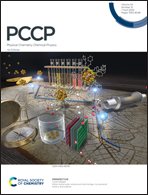Structural and electronic properties for Be-doped Ptn (n = 1–12) clusters obtained by DFT calculations†
Abstract
In this work, we have performed a computational study on the structure and electronic properties for Be-doped Ptn (n = 1–12) clusters in the framework of density functional theory (DFT). The most stable structures of the clusters are obtained by a structure search procedure based in simulated annealing. The results show that the PtnBe clusters adopt compact structure motifs with Be situated at the edge sites while only in Pt11Be the Be atom occupies the center site. The energetic parameters showed that Pt5Be, Pt7Be and Pt10Be are the most stable ones. The PtnBe clusters with (n = 5–7) have similar vertical ionization potential (vIP) and vertical electron affinity (vEA) parameters compared to the unary Pt clusters, while Pt9Be and Pt11Be have the higher vEA values. In particular, the d-band center is slightly higher for the doped clusters, suggesting an enhanced reactivity. The σ-holes are found more remarkable for the doped clusters, which are situated in the Be dopant and low coordinated Pt sites. The data on the infrared spectra of the clusters is also provided and showed a significant blue shift due to the vibrational modes of the Be atom. These results are useful for understanding the fundamental properties of Be-doped Ptn clusters in the subnanometer region.



 Please wait while we load your content...
Please wait while we load your content...